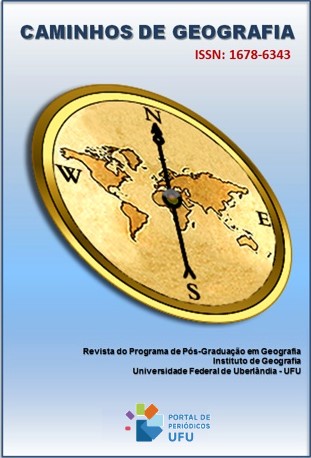AVALIAÇÃO DA DINÂMICA DA PAISAGEM E HETEROGENEIDADE DE MANCHAS FLORESTAIS NO CONTEXTO DO NEXO FLORESTA-ÁGUA-SOCIEDADE EM DUAS BACIAS HIDROGRÁFICAS EM JUNDIAÍ – SP
DOI:
https://doi.org/10.14393/RCG249364876Palavras-chave:
Uso e cobertura da terra, Serviços ecossistêmicos, Métricas de paisagem, GeoprocessamentoResumo
A heterogeneidade espacial, temporal e funcional é relevante na identificação de gargalos e oportunidades para a gestão de bacias hidrográficas de abastecimento e se constitui em elemento para a apreensão das relações floresta-água-sociedade. Este estudo realizou uma análise espacial e temporal em duas bacias hidrográficas, visando identificar as mudanças ocorridas na composição e na configuração da paisagem, com foco em manchas florestais e sua funcionalidade para a produção de água. Utilizou-se geoprocessamento e aplicação das métricas AREA, ENN, PROXRIO e SHAPE para avaliar a configuração das manchas florestais nas bacias em 1985 e 2020. Constatou-se um processo importante de urbanização nas bacias, predominantemente sobre áreas agropecuárias, e que vêm ocorrendo em paralelo ao incremento líquido de cobertura florestal. Tal cobertura florestal representa 37,3% do território, estando distribuída de modo desigual na paisagem. A proximidade existente entre os fragmentos pode ser incrementada a partir da restauração das Áreas de Preservação Permanente (APPs) ocupadas por atividades agrícolas, que perfazem 34,3% das APPs hídricas. Conclui-se que deve haver uma política de desmatamento zero nas bacias, com expansão dos usos antrópicos somente sobre áreas já degradadas, associado ao incentivo à restauração de florestas em toda a paisagem, como estratégia para a gestão do território.
Downloads
Downloads
Publicado
Edição
Seção
Licença
Copyright (c) 2023 Felipe Rosafa Gavioli, Caio Molena, Raquel Carnivalle Silva Melillo, Paulo Guilherme Molin, Alexandre Marco da Silva

Este trabalho está licenciado sob uma licença Creative Commons Attribution-NonCommercial-NoDerivatives 4.0 International License.
Autores que publicam nesta revista concordam com os seguintes termos: a) Autores mantém os direitos autorais e concedem à revista o direito de primeira publicação, com o trabalho licenciado sob a Creative Commons Atribuição-NãoComercial-SemDerivações 4.0 Internacional. b) Autores têm permissão e são estimulados a publicar e distribuir seu trabalho online (ex.: em repositórios institucionais ou na sua página pessoal), já que isso pode gerar alterações produtivas, bem como aumentar o impacto e a citação do trabalho publicado. c) Em virtude de aparecerem nesta revista de acesso público, os artigos são de uso gratuito, com atribuições próprias, em aplicações educacionais e não-comerciais.











